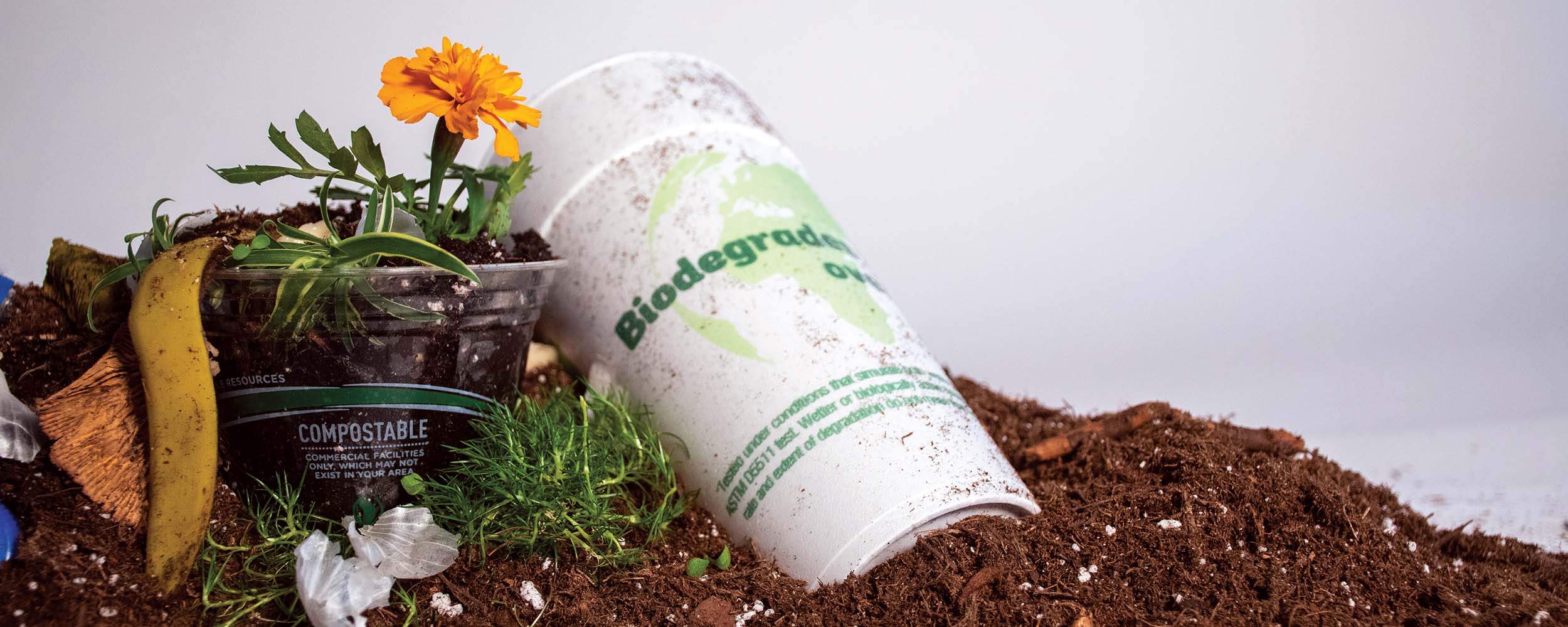
Composting the Plastic
Wednesday, May 24, 2023
Media Contact: Kristin Knight | Communications and Marketing Manager | 405-744-1130 | kristin.knight@okstate.edu
Landfills are home to discarded fast food containers and daily trash. However, products described as recyclable also can be found in piles of garbage when not properly thrown out.
To combat this, researchers in the Oklahoma State University Ferguson College of Agriculture continue to develop new techniques to allow compostable plastic products to decompose more quickly.
“By giving compostable plastics a ‘pretreatment,’ such as heat, and placing them in a compost pile containing microbes, they can fully break down in as little as 19 days,” said Danielle Bellmer, a professor both in the OSU Department of Biosystems and Agricultural Engineering and in the Robert M. Kerr Food and Agricultural Products Center.
The current standard for degradation with compostable plastics is around 45 days, she said. Compostable plastics are able to break down but don’t degrade as quickly as food scraps in a compost pile, she added.
The BAE department and FAPC plan to work with the OSU Office of Sustainability to research compostable plastics with additional pretreatment processes, Bellmer said.
Bellmer tests the degradation of compostable plastics in a FAPC lab with help from Tatumn Kennedy, a BAE freshman.
“Simply, most plastics are made from finite resources that plague the environment because there is no easy way to break them down, especially in a landfill,” Kennedy said.
Compostable plastics are one type of biodegradable plastic, Bellmer said. Made from polylactic acid, they can break down when composted more than a few months, she added.
Single-use plastics, such as water bottles, plastic bags, utensils and cups, are the main contributors to microplastics in the environment, Kennedy said. Compostable plastics are a better option; however, few facilities can process these plastics using a traditional composting method, she added.
The OSU Office of Sustainability has investigated the process of switching to compostable plastics, said Kristeena Blaser, former coordinator for the department.
“No local compost facility would allow for the proper treatment,” Blaser said. “Without a facility to process the compostable plastics, it would do little good to switch to them as they would still end up in the waste stream going to a landfill.”
The same issue occurs with biodegradable plastic as with compostable — a facility is needed to create the conditions for these products to break down, which most landfills do not have, she said.
Over many years, biodegradable plastics break down in ideal conditions, Bellmer said.
“If the conditions are not created or met, these plastics will not biodegrade,” Bellmer added.
“Take an OSU Dining cup, for example,” Bellmer said. “It says, ‘Biodegrades 92% over 4 years.’ Many people miss the fine print below stating, ‘Tested under conditions that simulate both wetter and more biologically active landfills.’”
Using aluminum, glass or reusable containers is a better option for the environment, she said, and aluminum can be recycled more efficiently.
Using reusable containers, bags and utensils can be a better option than choosing plastics, Kennedy said.
“We may have had it right when stores had glass milk jugs and collected container deposits and restaurants washed dishes,” Bellmer said.
OSU officials are developing goals and objectives for the next decade as part of the Campus Sustainability Plan, Blaser said.
It is a slow process for the OSU campus to switch to biodegradable items; however, the future looks promising, Blaser said.
“Being aware of plastic options around you and playing your part in properly disposing of waste plays a small part in this large issue,” Kennedy said. “Just be mindful of your waste and think green.”
Recyling plastics
Recycling plastic involves separating products based on type, followed by melting
and remolding the plastic for another use, said Kristeena Blaser, former coordinator
for the OSU Office
of Sustainability.
The seven major categories of recyclable plastics are polyethylene terephthalate, high-density polyethylene, polyvinyl chloride, low-density polyethylene, polypropylene, polystyrene and others. These are labeled 1 through 7 on the recycle chart.
“If there is no number on the plastic item or you are unsure if it is recyclable, it is best to put the item in the waste bin to avoid contaminating the recycling bin,” Blaser said.
Even if the item has a number, not all numbers are accepted in recycling streams.
“Numbers 1, 2 and 5 are the only plastic items OSU can accept at this time,” Blaser said.
“If enough plastic items not accepted by your local municipal recycling facility are found, the entire group could be considered contaminated and sent to the landfill,” she added.
Story By: Austin Reim | Cowboy Journal
